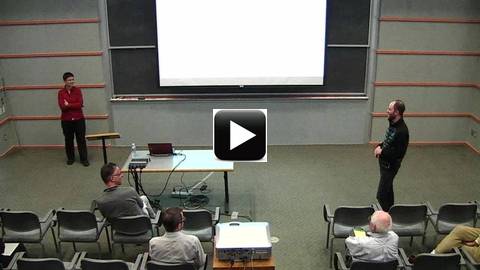Photoassociation, assembling molecules using laser light, represents the simplest example of a light-induced binary reaction. Controlling a binary reaction employing quantum interferences remains an open goal since the early days of coherent control. On the other hand, coherent control has been successfully demonstrated for unimolecular processes such as ionization or dissociation after the advent of femtosecond lasers and pulse shaping techniques. The main difference between unimolecular processes and a binary reaction lies in the initial state - a single or few well-defined bound quantum states vs an incoherent continuum of scattering states. Essentially, photoassociation corresponds to filtering out a small part of the initial incoherent ensemble. I will discuss how tuning quantum resonances at low temperature, prior to photoassocation, can be utilized to modify the initial ensemble and thus enhance the reaction rate.
The main tool of coherent control are femtosecond lasers. To date,
coherent control of photoassociation at low temperatures has been
hampered by the apparant disparity between the broad spectral width of
femtosecond lasers and narrow-width photoassociation transitions. A
remedy is provided by employing multi-photon transitions which allow for
destructive interference of optical pathways in order to suppress the
undesired excitation of atoms. I will discuss how to optimize
multi-photon femtosecond photoassociation.
 Other video options
Other video options
To begin viewing slides, click on the first slide below. (Or, view as pdf.)
![[01]](tn/01.jpg)
![[02]](tn/02.jpg)
![[03]](tn/03.jpg)
![[04]](tn/04.jpg)
![[05]](tn/05.jpg)
![[06]](tn/06.jpg)
![[07]](tn/07.jpg)
![[08]](tn/08.jpg)
![[09]](tn/09.jpg)
![[10]](tn/10.jpg)
![[11]](tn/11.jpg)
![[12]](tn/12.jpg)
![[13]](tn/13.jpg)
![[14]](tn/14.jpg)
![[15]](tn/15.jpg)
![[16]](tn/16.jpg)
![[17]](tn/17.jpg)
![[18]](tn/18.jpg)
![[19]](tn/19.jpg)
![[20]](tn/20.jpg)
![[21]](tn/21.jpg)
![[22]](tn/22.jpg)
![[23]](tn/23.jpg)
![[24]](tn/24.jpg)
![[25]](tn/25.jpg)
![[26]](tn/26.jpg)
![[27]](tn/27.jpg)
![[28]](tn/28.jpg)
![[29]](tn/29.jpg)
![[30]](tn/30.jpg)
![[31]](tn/31.jpg)
![[32]](tn/32.jpg)
![[33]](tn/33.jpg)
![[34]](tn/34.jpg)
![[35]](tn/35.jpg)
![[36]](tn/36.jpg)
![[37]](tn/37.jpg)
![[38]](tn/38.jpg)
![[39]](tn/39.jpg)
![[40]](tn/40.jpg)
![[41]](tn/41.jpg)
![[42]](tn/42.jpg)
![[43]](tn/43.jpg)
![[44]](tn/44.jpg)
![[45]](tn/45.jpg)
![[46]](tn/46.jpg)
![[47]](tn/47.jpg)
![[48]](tn/48.jpg)
![[49]](tn/49.jpg)
![[50]](tn/50.jpg)
![[51]](tn/51.jpg)
![[52]](tn/52.jpg)
![[53]](tn/53.jpg)
![[54]](tn/54.jpg)
![[55]](tn/55.jpg)
![[56]](tn/56.jpg)
![[57]](tn/57.jpg)
![[58]](tn/58.jpg)
![[59]](tn/59.jpg)
![[60]](tn/60.jpg)
![[61]](tn/61.jpg)
![[62]](tn/62.jpg)
![[63]](tn/63.jpg)
![[64]](tn/64.jpg)
![[65]](tn/65.jpg)
![[66]](tn/66.jpg)
![[67]](tn/67.jpg)
![[68]](tn/68.jpg)
![[69]](tn/69.jpg)
![[70]](tn/70.jpg)
![[71]](tn/71.jpg)
![[72]](tn/72.jpg)